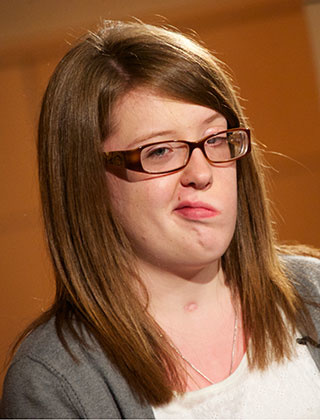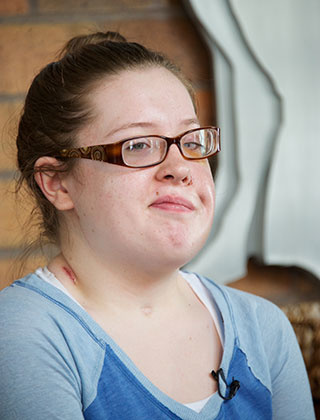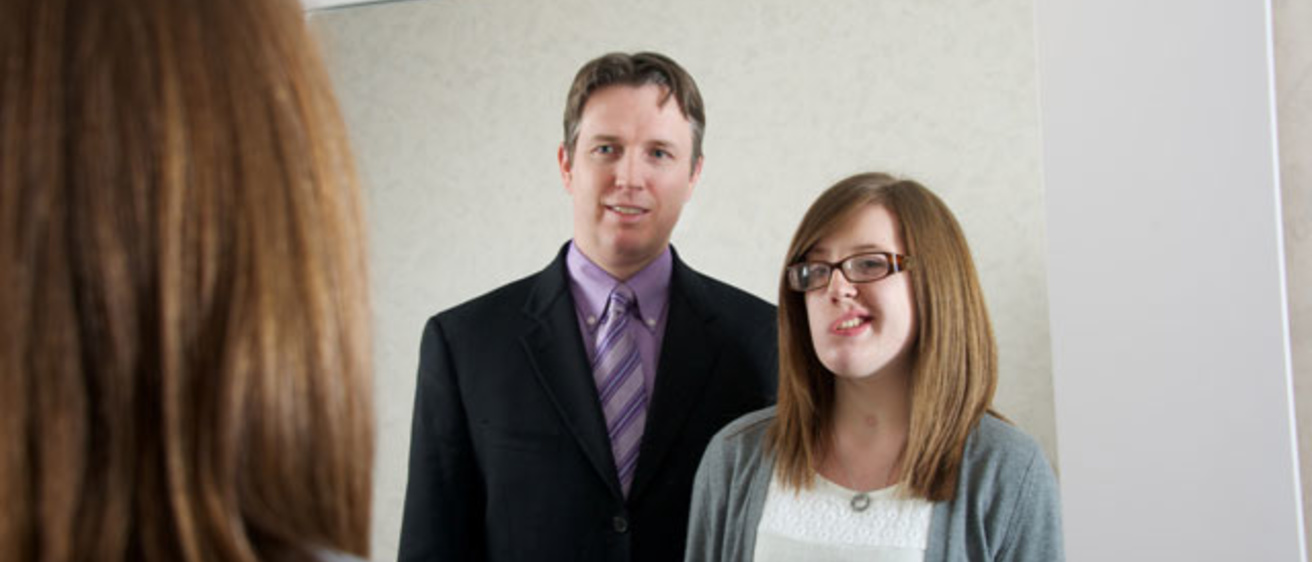Spend a few minutes talking to Natalie Wright and there's no doubting the happy nature of this bright, soft-spoken 15-year-old from Provo, Utah. But Natalie's dream is to be able to express her inner happiness without words, using her whole face instead.
Natalie wants a natural smile—that nonverbal, universally recognized flash of friendliness that most of us take for granted, but which has eluded Natalie for most of her life. At age 2, she was diagnosed with a brain tumor. Three surgeries and chemotherapy have kept the tumor under control, but the treatments paralyzed one side of Natalie's face, leaving her with left-sided vision and hearing loss and a one-sided smile.
Now, thanks to a chance conversation with a neighbor and the expertise of a University of Iowa facial plastic surgeon, Natalie’s simple wish for a full smile is within reach.
"When she was a little girl of 5, she used to brush her teeth in the mornings and she'd push the left side up to try to get it to smile," says Dana Wright, Natalie's mom. "So for her this is a huge undertaking because she always says. 'I want people to know how I feel on the outside because I'm happy on the inside.'"
Last year, Natalie's neurosurgeon in Provo told her about a technique called facial reanimation that might restore a more natural, two-sided smile. As the Wrights started to explore options, a happy coincidence connected them with Douglas Henstrom, a facial nerve specialist with Provo roots who is director of facial plastic and reconstructive surgery and the Facial Nerve Center at UI Hospitals and Clinics in Iowa City.
"Our neighbor in Provo called us over to share some peanut brittle and she asked us about Natalie's surgery," recalls Dana. "She told us about her niece's husband, Doug Henstrom, who was doing this. He had trained at Harvard and at Mayo Clinic and was just opening a center at UI Hospitals and Clinics in Iowa City. And we knew, we knew instantly, and we couldn't wait to get home and Skype him, which we did, and he thought Natalie was a great candidate for this surgery."
"We looked him up on the Internet, too, and found that he had gone to my high school—that was cool," Natalie adds.
A journey begins
In April 2012, Natalie and her family arrived at UI Children's Hospital to start the process that would return Natalie’s smile. The Facial Nerve Center, established by Henstrom in 2011, is one of only a few comprehensive facial nerve centers in the country—and the only one in Iowa—that specialize in the treatment of patients with facial nerve paralysis.
Natalie is the first pediatric patient to receive facial reanimation surgery in Iowa. The procedure that Henstrom used involved two separate surgeries performed about a year apart. In the first surgery, in April 2012, Henstrom transplanted a sensory nerve from Natalie's ankle into her right cheek, connecting one end to her working "smile nerve" on that side and delicately threading the nerve’s other end under the skin above her upper lip and into her left cheek. Then everyone waited for a year to allow the transplanted nerve to heal and regain its function.
"I started regaining feeling about two months after the surgery. Since then it's just gradually improved and now I can feel it over here, on the left side of my face," Natalie explains. "I'm not a very patient person. But it's made me more patient and I'm excited in the long run—it will be good."
This week, one year later, Natalie and her parents returned to Iowa for the second surgery, in which Henstrom transferred part of Natalie's thigh muscle, with the accompanying blood vessels and the nerve, into her left cheek. He connected the nerve to the nerve graft that was put in place last year.
"Once the nerve graft has regenerated, it will provide an opportunity for the new muscle to be powered by the native facial nerve on the other side of the face," Henstrom explains. "It gives Natalie the opportunity to have an involuntary, natural smile—one she doesn't have to think about.”

A preview of a smile
The surgery on April 18 took 12 hours—a little longer than expected, but it included an additional procedure that transferred a small piece of tissue from Natalie's leg to the left side of her nose to lift it slightly and make it more symmetrical, helping her breathe more easily.

Although Natalie's nerve graft won't heal enough to activate her smile naturally for another six to 12 months, the surgery already has dramatically altered her face and given her a preview of what her smile will be. In part because of tautness of the transplanted muscle and in part because of post-surgery swelling, both expected to decrease over the next few weeks, the left side of Natalie's mouth is curved upward, revealing her first two-sided smile in 12 years.
Natalie first saw her new smile in the reflection on her iPhone the evening after the surgery.
"I was FaceTiming my sister and looking at my face in the screen. I said, 'Look Gabby, I'm not doing this, it's normal!'" she says. "It's cool, a little crazy, but cool."
"The biggest thing is that you can see her smile is back," says John Wright, Natalie's dad. "That 'inside' she is always talking about was definitely projecting on the outside."
What's in a smile?
Facial paralysis can have many causes. In adults it can occur due to Bell's palsy, Ramsey Hunt syndrome, brain tumors, or other head and neck cancers that affect the facial nerve. Facial paralysis is less common in children, where it is most often caused by a brain tumor, as in Natalie's case.
According to Henstrom, an estimated two in every 10,000 Americans will develop some facial paralysis each year. The majority of those cases are due to Bell's palsy, which spontaneously resolves for 85 percent of individuals. However, that suggests every year a few thousand people with facial paralysis do not recover fully.
"Smile reanimation surgery is quite rare. And facial paralysis, in general, is at best an undertreated problem for patients," Henstrom says. "Historically, the thinking has been that there is not much that can be done for patients with facial paralysis, and that's just simply not true anymore. There are a lot of options we have that we can offer to patients.
"When someone has facial paralysis they lose a lot of their ability to communicate nonverbally. So, often, patients with facial paralysis will tell you that they feel misunderstood," he continues. "Being able to give these patients more balanced symmetry in their smile, and even some movement, gives them so much more in the way of nonverbal communications."
Henstrom notes that the surgery also brings other quality of life benefits. For example, lifting the corner of the mouth allows people to eat and drink without spilling, which can give them the confidence to go out to eat.
"I'm very excited for Natalie. I'm really happy with the success I can already see from the surgery. I'm also excited for the possibility that this might make other people aware of what is possible," Henstrom adds.
The journey continues
Natalie and her family will now return to Provo and resume their normal lives as they wait for the nerve graft to heal. They will remain in close contact with Henstrom and let him know as soon as Natalie starts to regain movement.
The Wrights are grateful to the many people who have helped along the way, including Henstrom and his team at UI Children's Hospital for their expert care of Natalie; Natalie's doctors in Provo who advocated on her behalf to ensure that she was able to have the surgery in Iowa City; the staff at the Ronald McDonald House where they stayed on both visits; and a company called Flyer Smiles, which donated a free flight to the family.
"Natalie's journey has definitely had its ups and downs. But this—to be able to have a smile—is bigger than any Christmas list for her. So we're very grateful for the opportunity to be here and have that possibility," Dana says. "Looking at Natalie and seeing the joy in her face, it feels like it couldn't have been more perfect."
To follow Natalie's progress, visit her website at www.nataliewright.com.
